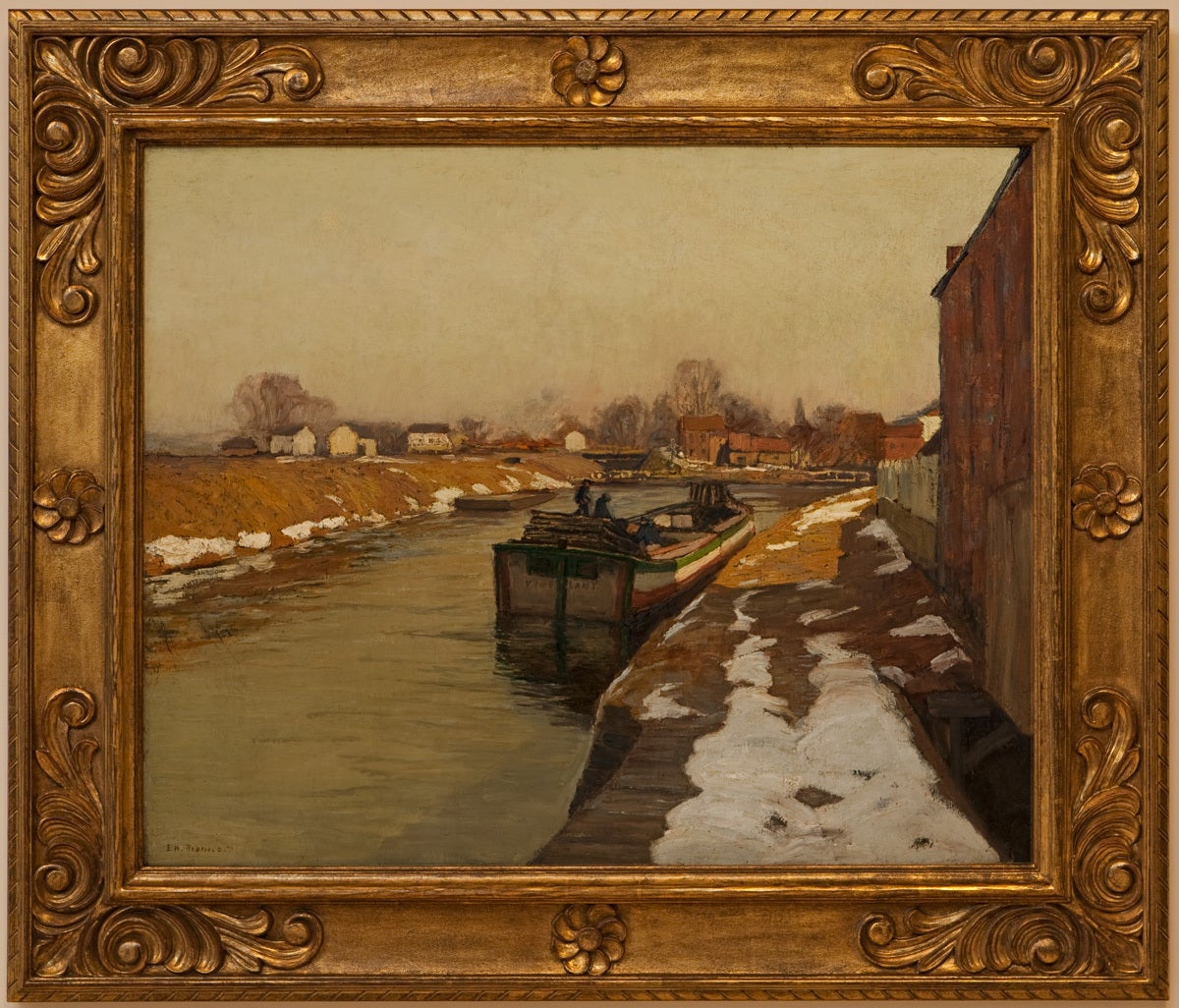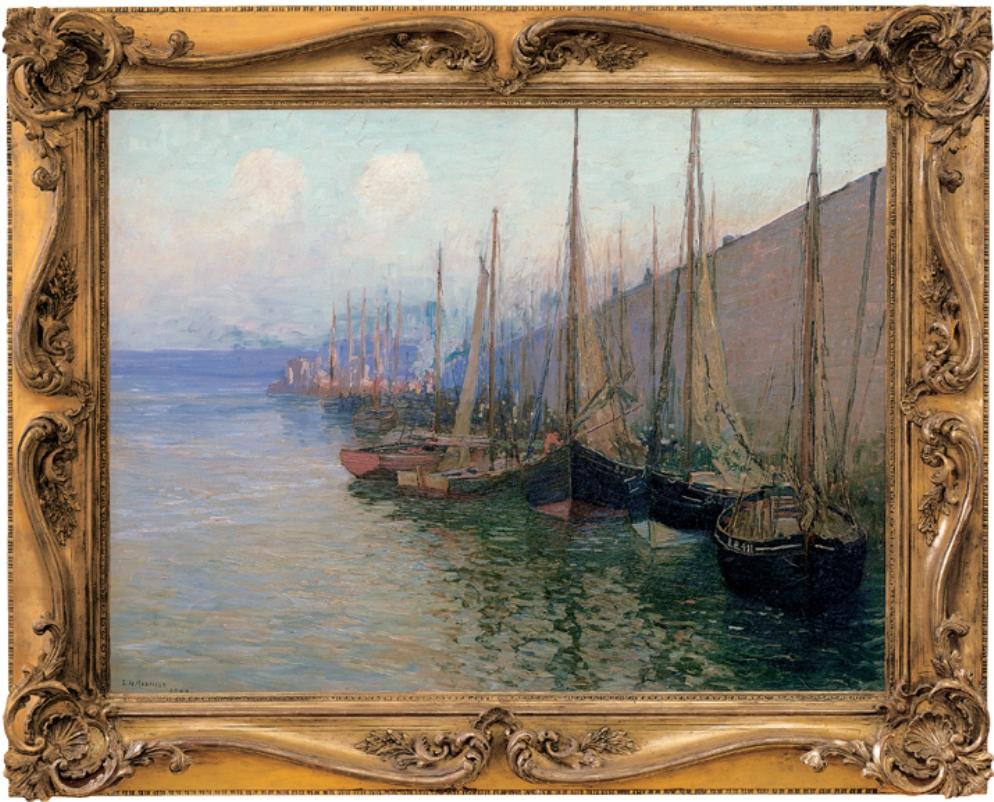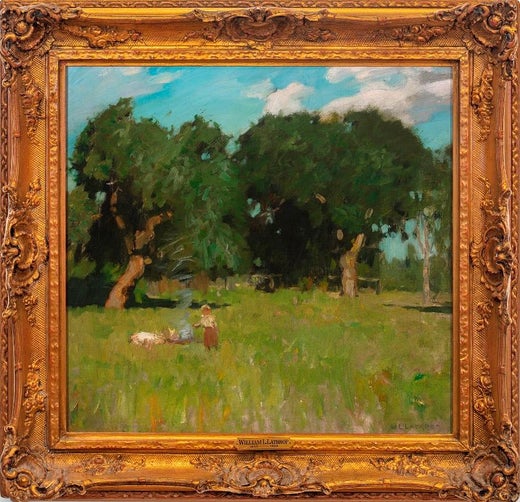William Langson Lathrop"Solebury Valley"c. 1910
c. 1910
About the Item
- Creator:William Langson Lathrop (1859-1938, American)
- Creation Year:c. 1910
- Dimensions:Height: 40 in (101.6 cm)Width: 60 in (152.4 cm)Depth: 3 in (7.62 cm)
- More Editions & Sizes:Frame Size 40" x 59" x 3"Price: $243,750
- Medium:
- Movement & Style:
- Period:
- Condition:
- Gallery Location:Lambertville, NJ
- Reference Number:
William Langson Lathrop
William Langson Lathrop, deemed the Father of the New Hope Art Colony, was born in Warren, Illinois. He was largely self-taught, having only studied briefly with William Merritt Chase in 1887 at the Art Students League. Lathrop first moved east in the early 1880s and took a job at the Photo-engraving Company in New York City. While there, he befriended fellow employee, Henry B. Snell. The two men became lifelong friends and ultimately, both would be considered central figures among the New Hope Art Colony. Lathrop’s early years as an artist were ones of continuing struggles. His efforts to break through in the New York art scene seemed futile, so he scraped enough money together and traveled to Europe with Henry Snell in 1888. There, he met and married an English girl, Annie Burt. Upon returning to New York, he tried his hand at etching, making tools from old saw blades. Even though his prints were extremely beautiful, he remained impoverished.
Lathrop would return to his family in Ohio, before once again attempting the New York art scene. In 1899, with great trepidation, he submitted five small watercolors to an exhibit at the New York Watercolor Club. He won the Evans Prize, the only award given, and four of the five paintings were sold the opening night. At age 40, Lathrop’s career would finally take off as he became an overnight success. Lathrop came to Phillips Mill for the first time in 1898 to visit his boyhood friend, Dr. George Marshall. Shortly after, he and his family purchased the old miller’s house from Dr. Marshall. The Lathrop’s home became a social and artistic center for the growing New Hope artists’ community. Tea and fascinating conversation were the “order of the day” every Sunday. This was a scene fondly recalled by many younger art students who Lathrop taught privately at Phillips Mill. It was common to see groups of his students painting and sketching along the banks of the canal or aboard his boat. He had previously taught in the Poconos and at the Lyme Summer School in Lyme, Connecticut in 1907, but Phillips Mill always remained Lathrop’s permanent address.
In 1928, a committee headed by Lathrop was formed to purchase the old Phillips Mill building as a place to hold community gatherings and art exhibitions. The committee had success and in 1929, the Phillips Mill Community Association was formed. This became the center of the New Hope Art Colony, holding annual exhibitions, and continues its operations today. In 1930, Lathrop built a sailboat, which he named the “Widge”. For eight consecutive seasons, he sailed it along the coast of Long Island, painting as he cruised. In 1938, while trying to ride out a storm off of Montauk, he died aboard his beloved “Widge” during the hurricane. Lathrop is remembered not only for his leading role as founder of the New Hope Art Colony, but as one of the most talented artists to emerge from this group of painters. His atmospheric and tonalist works as well as his colorful Impressionist landscapes are highly sought after by collectors. Relatively prolific throughout his career, Lathrop’s paintings still remain one of the greatest values among the important New Hope painters. His work is in the permanent collections of over 20 museums throughout the United States. William Lathrop exhibited at the Pennsylvania Academy of the Fine Arts (1922 Gold Medal), the Art Institute of Chicago, the Boston Art Club, the American Watercolor Society, the New York Watercolor Club (1899 prize), the National Academy of Design, the Philadelphia Art Club (Gold Medal), the Society of American Artists (1899 prize), the Worcester Art Museum (1904 prize), the Corcoran Gallery Biennials and the Panama-Pacific Exposition in San Francisco (1915 Gold Medal).
- ShippingRetrieving quote...Ships From: Lambertville, NJ
- Return PolicyThis item cannot be returned.
- "Alley Fiends"By John R. GrabachLocated in Lambertville, NJJim’s of Lambertville is proud to offer this artwork by: John R. Grabach (1886 - 1981) John Grabach was a highly regarded New Jersey artist, teacher, and author of the classic text...Category
1930s American Impressionist Landscape Paintings
MaterialsCanvas, Oil
- "Forest Strongholds"By John F. CarlsonLocated in Lambertville, NJSigned lower right. Complemented by a hand carved and gilt frame. Exhibited at the National Academy of Design, 1928Category
20th Century American Impressionist Landscape Paintings
MaterialsCanvas, Oil
- Winter MoonlightBy George William SotterLocated in Lambertville, NJsigned lower rightCategory
1910s American Impressionist Landscape Paintings
MaterialsCanvas, Oil
- "The Canal"By Edward Willis RedfieldLocated in Lambertville, NJJim’s of Lambertville is proud to offer this artwork. Signed lower left. Complemented by a hand carved and gilt frame. Illustrated in "Edward Redfield: Just Values and Fine Seeing" by Constance Kimmerle and the Pennsylvania Academy of the Fine Arts's Exhibition of Paintings by Edward Redfield (April 17 to May 16, 1909) brochure Edward Willis Redfield (1869 - 1965) Edward W. Redfield was born in Bridgeville, Delaware, moving to Philadelphia as a young child. Determined to be an artist from an early age, he studied at the Spring Garden Institute and the Franklin Institute before entering the Pennsylvania Academy from 1887 to 1889, where he studied under Thomas Anshutz, James Kelly, and Thomas Hovenden. Along with his friend and fellow artist, Robert Henri, he traveled abroad in 1889 and studied at the Academie Julian in Paris under William Bouguereau and Tony Robert-Fleury. While in France, Redfield met Elise Deligant, the daughter of an innkeeper, and married in London in 1893. Upon his return to the United States, Redfield and his wife settled in Glenside, Pennsylvania. He remained there until 1898, at which time he moved his family to Center Bridge, a town several miles north of New Hope along the Delaware River. Redfield painted prolifically in the 1890s but it was not until the beginning of the twentieth century that he would develop the bold impressionist style that defined his career. As Redfield’s international reputation spread, many young artists gravitated to New Hope as he was a great inspiration and an iconic role model. Edward Redfield remained in Center Bridge throughout his long life, fathering his six children there. Around 1905 and 1906, Redfield’s style was coming into its own, employing thick vigorous brush strokes tightly woven and layered with a multitude of colors. These large plein-air canvases define the essence of Pennsylvania Impressionism. By 1907, Redfield had perfected his craft and, from this point forward, was creating some of his finest work. Redfield would once again return to France where he painted a small but important body of work between 1907 and 1908. While there, he received an Honorable Mention from the Paris Salon for one of these canvases. In 1910 he was awarded a Gold Medal at the prestigious Buenos Aires Exposition and at the Panama-Pacific Exposition of 1915 in San Francisco, an entire gallery was dedicated for twenty-one of his paintings. Since Redfield painted for Exhibition with the intent to win medals, his best effort often went into his larger paintings. Although he also painted many fine smaller pictures, virtually all of his works were of major award-winning canvas sizes of 38x50 or 50x56 inches. If one were to assign a period of Redfield’s work that was representative of his “best period”, it would have to be from 1907 to 1925. Although he was capable of creating masterpieces though the late 1940s, his style fully matured by 1907 and most work from then through the early twenties was of consistently high quality. In the later 1920s and through the 1930s and 1940s, he was like most other great artists, creating some paintings that were superb examples and others that were of more ordinary quality. Redfield earned an international reputation at a young age, known for accurately recording nature with his canvases and painting virtually all of his work outdoors; Redfield was one of a rare breed. He was regarded as the pioneer of impressionist winter landscape painting in America, having few if any equals. Redfield spent summers in Maine, first at Boothbay Harbor and beginning in the 1920s, on Monhegan Island. There he painted colorful marine and coastal scenes as well as the island’s landscape and fishing shacks. He remained active painting and making Windsor style furniture...Category
Early 1900s American Impressionist Landscape Paintings
MaterialsCanvas, Oil
- "In Port"By Edward Willis RedfieldLocated in Lambertville, NJJim’s of Lambertville is proud to offer this artwork by: Edward Willis Redfield (1869 - 1965) Edward W. Redfield was born in Bridgeville, Delaware, moving to Philadelphia as a young child. Determined to be an artist from an early age, he studied at the Spring Garden Institute and the Franklin Institute before entering the Pennsylvania Academy from 1887 to 1889, where he studied under Thomas Anshutz, James Kelly, and Thomas Hovenden. Along with his friend and fellow artist, Robert Henri, he traveled abroad in 1889 and studied at the Academie Julian in Paris under William Bouguereau and Tony Robert-Fleury. While in France, Redfield met Elise Deligant, the daughter of an innkeeper, and married in London in 1893. Upon his return to the United States, Redfield and his wife settled in Glenside, Pennsylvania. He remained there until 1898, at which time he moved his family to Center Bridge, a town several miles north of New Hope along the Delaware River. Redfield painted prolifically in the 1890s but it was not until the beginning of the twentieth century that he would develop the bold impressionist style that defined his career. As Redfield’s international reputation spread, many young artists gravitated to New Hope as he was a great inspiration and an iconic role model. Edward Redfield remained in Center Bridge throughout his long life, fathering his six children there. Around 1905 and 1906, Redfield’s style was coming into its own, employing thick vigorous brush strokes tightly woven and layered with a multitude of colors. These large plein-air canvases define the essence of Pennsylvania Impressionism. By 1907, Redfield had perfected his craft and, from this point forward, was creating some of his finest work. Redfield would once again return to France where he painted a small but important body of work between 1907 and 1908. While there, he received an Honorable Mention from the Paris Salon for one of these canvases. In 1910 he was awarded a Gold Medal at the prestigious Buenos Aires Exposition and at the Panama-Pacific Exposition of 1915 in San Francisco, an entire gallery was dedicated for twenty-one of his paintings. Since Redfield painted for Exhibition with the intent to win medals, his best effort often went into his larger paintings. Although he also painted many fine smaller pictures, virtually all of his works were of major award-winning canvas sizes of 38x50 or 50x56 inches. If one were to assign a period of Redfield’s work that was representative of his “best period”, it would have to be from 1907 to 1925. Although he was capable of creating masterpieces though the late 1940s, his style fully matured by 1907 and most work from then through the early twenties was of consistently high quality. In the later 1920s and through the 1930s and 1940s, he was like most other great artists, creating some paintings that were superb examples and others that were of more ordinary quality. Redfield earned an international reputation at a young age, known for accurately recording nature with his canvases and painting virtually all of his work outdoors; Redfield was one of a rare breed. He was regarded as the pioneer of impressionist winter landscape painting in America, having few if any equals. Redfield spent summers in Maine, first at Boothbay Harbor and beginning in the 1920s, on Monhegan Island. There he painted colorful marine and coastal scenes as well as the island’s landscape and fishing shacks. He remained active painting and making Windsor style furniture...Category
Early 1900s American Impressionist Landscape Paintings
MaterialsCanvas, Oil
- “Evening in Newark”By John R. GrabachLocated in Lambertville, NJIllustrated in "New Hope for American Art", pg. 194. Jim’s of Lambertville is proud to offer this artwork by: John R. Grabach (1886 - 1981) John Grabach was a highly regarded New ...Category
20th Century American Impressionist Landscape Paintings
MaterialsCanvas, Oil
- Laguna HillsBy William WendtLocated in Palm Desert, CAA painting by William Wendt. "Laguna Hills" is an impressionist landscape, oil on canvas in an earth-tone palette by American artist William Wendt. The artwork is signed in the lower...Category
Early 20th Century American Impressionist Landscape Paintings
MaterialsOil, Canvas
- Peasant woman at work in the fields of CapriBy Charles Caryl ColemanLocated in Roma, RMCharles Caryl Coleman (Buffalo 1840 – Capri 1928), Peasant woman at work in the fields of Capri (1901) Oil painting on canvas 35 x 49 cm, signed, located and dated Capri 1901 lower ...Category
Early 1900s American Impressionist Landscape Paintings
MaterialsCanvas, Oil
- The Island, DANIEL RIDGWAY KNIGHT - American Impressionist, Realism, Landscape,By Daniel Ridgway KnightLocated in London, GBOil on canvas 46 x 55 cm (18 ⅛ x 21 ⅝ inches) Signed lower left, Ridgway Knight Artist biography American artist Daniel Ridgway Knight was born in Pennsylvania and studied at the École des Beaux-Arts in Paris. From 1872 he lived and worked at Poissy on the River Seine, just to the west of Paris. Best known for his landscapes and depictions of peasant women in the fields, Knight earned distinction at the Paris Salon of 1882. He went to be was awarded the Silver Medal and Cross of the Legion d’Honneur at the Exposition Universelle in 1889, the Gold Medal of Honour from the Pennsylvania Academy of Fine Arts in 1893 and in that same year was created a Knight of the Royal Order...Category
Late 19th Century American Impressionist Landscape Paintings
MaterialsOil, Canvas
- Grey Day on the BayBy Lu HaskewLocated in Loveland, CO"Grey Day on the Bay" by Lu Haskew Oil 24x28" framed, 16x20" image size Signed lower left When Lu visited her sister in Oregon she always made a point of visiting the ships at dock ...Category
Early 2000s American Impressionist Paintings
MaterialsCanvas, Oil
- Bird Bath, 10x8" oil on boardBy Lu HaskewLocated in Loveland, COBird Bath by Lu Haskew Oil Painting of backyard garden 10x8" image size 18x16" framed Shipping price includes the custom packing necessary for safe transport of fine art. ABOUT THE...Category
Early 2000s American Impressionist Paintings
MaterialsCanvas, Oil, Board
- Not Fishing Today, 8x10" oil on boardBy Lu HaskewLocated in Loveland, CONot Fishing Today by Lu Haskew Oil 8x10" image size Landscape Painting, Boat at Dock This painting is unframed, canvas on gator board, the price reflects that it is unframed. ABOUT THE ARTIST: Lu Haskew 1921-2009 "Life is good to me. Being able to go to my studio five days weekly and paint for several hours, living in a supportive community, having family and friends who encourage me--all have contributed to helping me become an artist. Being fortunate to study with some of the artists I admire has kept me painting from the garden, people and my favorite things. With the support of galleries, teaching and doing demos, how could I do anything else? My goal is to try to be the best I can be by always being a student, looking for new ideas and stretching my horizons." Upon retirement from a 33-year teaching career, Lu rented a studio in Loveland and began concentrating on her oil and watercolor painting. Learning from artists she had followed and admired throughout the years her painting became a full time career that lasted 17-years. Beginning in 1992, she studied with renowned painters Richard Schmid, Clyde Aspevig, Joyce Pike...Category
Early 2000s American Impressionist Paintings
MaterialsCanvas, Oil, Board






